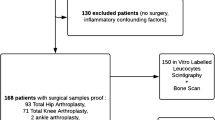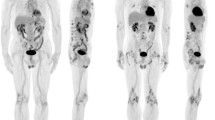Abstract
Abdominal scintigraphy with technetium-99m hexamethylpropylene amine oxime (99mTc-HMPAO)-labelled leucocytes is an excellent tool for evaluating disease extent and activity of intestinal lesions in patients with inflammatory bowel disease (IBD). In some cases of seronegative spondylarthropathies (SSp), IBD may remain subclinical. The aim of this study was to evaluate the presence of positive abdominal scintigraphy in patients with SSp and without clinical symptoms or signs of IBD. To this end we studied 32 patients with active SSp (European Spondylarthropathy Study Group 1991 criteria) without clinical evidence of IBD (eight had ankylosing spondylitis, four psoriatic arthritis, three reactive arthritis an 17 undifferentiated SSp) and 11 controls without SSp. All SSp and control patients received similar doses of non-steroidal anti-inflammatory drugs (NSAIDs). Abdominal scintigraphic images were obtained at 30 and 120 min after re-injection of99mTc-HMPAO-labelled leucocytes. The99mTc-HMPAO-labelled leucocyte scan was positive in 17 patients with SSp (53.1%) (six with ankylosing spondylitis, three with psoriatic arthritis, two with reactive arthritis and six with undifferentiated SSp). Fourteen patients scored from 2 to 4 on the intensity of uptake scale. The colon and terminal ileum were predominantly involved. Axial involvement was more frequent in patients with a positive scan than in patients with negative results (P<0.05) (64.7% vs 26.6%; odds ratio: 5). No control patient showed a positive scan. It is concluded that99mTc-HMPAO-labelled leucocyte scan shows increased uptake among patients with SSp without evidence of IBD. These findings provide new evidence linking SSp with intestinal inflammation and suggest that in some cases a bowel-related process could contribute to the development of SSp. Longterm follow-up studies with more patients are necessary to evaluate the diagnostic and therapeutic implications of these results.
Similar content being viewed by others
References
Schölmerich J, Schmidt E, Schmemichen C et al. Scintigraphic assessment of bowel involvement and disease activity in Crohn's disease using technetium 99m-hexamethylpropylene amine oxime as leukocyte label.Gastroenterology 1988; 95: 1287–1293.
Schmemichen C, Schoelmerich J. Specificity of Tc-99m HMPAO-labelled leukocyte uptake in the large bowel as an indicator of inflammatory bowel disease.Nuklearmedizin 1987; 24: 370–374.
Lantto E, Járvi K, Krekelä I, et al. Technetium-99m hexamethylpropylene amine oxime leukocytes in the assessment of disease activity in inflammatory bowel disease.Eur J Nucl Med 1992; 19: 14–18.
Mielants H, Veys EM, Joos R, et al. Late onset pauciarticular juvenile chronic arthritis: relation to gut inflammation.J Rheumatol 1987; 14: 459–465.
De Vos M, Cuvelier C, Mielants H, et al. Ileo-colonoscopy in seronegative spondylarthropathy.Gastroenterology 1989; 96: 339–344.
Mielants H, Veys EM, Goemacre S, et al. Gut inflammation in the spondylarthropathies: clinical, radiologic, biologic and genetic features in relation to the type of histology. A prospective study.J Rheumatol 1991; 18: 1542–1551.
Leirisalo-Repo M, Turunen U, Stenman S, et al. High frequency of inflammatory bowel disease in spondylarthropathy.Arthritis Rheum 1994; 37: 23–31
González CM, Alonso JC, López-Longo FJ, et al. Abdominal scintigraphy in patients with seronegative spondylarthropathies without clinical evidence of inflammatory bowel disease [abstract]. XIth Annual General Meeting. British Society for Rheumatology, Brighton (England).Br J Rheumatol 1994; 33 Suppl 1:126.
Dougados M, Van der Linden S, Juhlin R, et al. The European Spondylarthropathy Study Group preliminary criteria for the classification of spondylarthropathy.Arthritis Rheum 1991; 34: 1218–1227.
Vorne M, Soini I, Lantto T, et al. Technetium-99m HMPAO-labelled leukocytes in detection of inflammatory lesions: comparison with gallium-67 citrate.J Nucl Med 1989; 30: 1332–1336.
Fleiss JL. Statistical methods for rates and proportions. New York: Wiley, 1981.
Lantto EH, Lantto T, Vorne M. Fast diagnosis of abdominal infections and inflammations with technetium-99m-HMPAO labeled leukocytes.J Nucl Med 1991; 32: 2029–2034.
Ebringer RW, Caudell DR, Couling P, et al. Sequential studies in ankylosing spondylitis. Association ofKlebsiella pneumoniae with active disease.Ann Rheum Dis 1978; 37: 146–151.
Olhagen B, Manson I. IntestinalClostridium perfringens in rheumatoid arthritis and other collagen diseases.Acta Med Scand 1968; 184: 394–402.
Van der Linden S, Valkenburg HA, Cats A. Evaluation of diagnostic criteria for ankylosing spondylitis: a proposal for modification of the New York criteria.Arthritis Rheum 1984; 27:361–368.
Mielants H, Veys EM, Cuvelier C, De Vos M. Ileocolonoscopic findings in seronegative spondylarthropathies.Br J Rheumatol 1988; 27 Suppl II: 95–105.
Taurog JD: Seronegative spondylarthropathies. Epidemiology, pathology and pathogenesis. In: Schumacher HR, Klippel JH, Koopman WJ, eds.Premier on the rheumatic diseases, 10th edn. Atlanta: Arthritis Foundation; 1993: 151–154.
Byarnason I, O'Morain C, Levi AI, et al. Absorption of chromium-51-labeled ethylene-diamine tetracetate in inflammatory bowel disease.Gastroenterology 1983; 5: 318–322.
Wendling D, Bider A, Guidet MD, et al. Intestinal permeability in ankylosing spondylitis.J Rheumatol 1990; 17: 114.
Fang WF, Broughton A, Jacobson ED. Indomethacin-induced intestinal inflammation.Am J Digest Dis 1977; 22: 749–760.
Author information
Authors and Affiliations
Rights and permissions
About this article
Cite this article
Alonso, J.C., Lopez-Longo, F.J., Lampreave, J.L. et al. Abdominal scintigraphy using99mTc-HMPAO-labelled leucocytes in patients with seronegative spondylarthropathies without clinical evidence of inflammatory bowel disease. Eur J Nucl Med 23, 243–246 (1996). https://doi.org/10.1007/BF00837621
Received:
Revised:
Issue Date:
DOI: https://doi.org/10.1007/BF00837621




